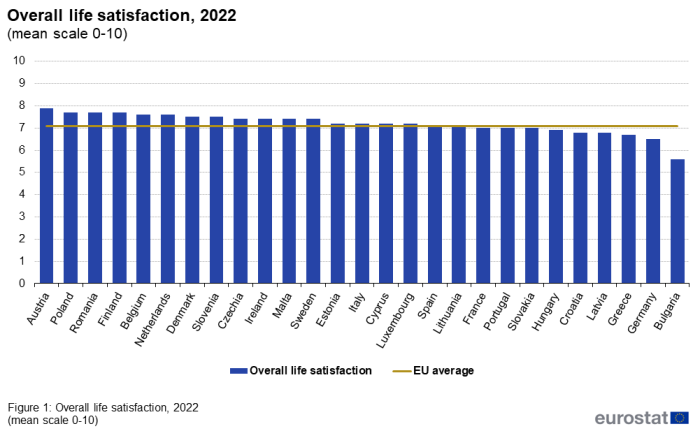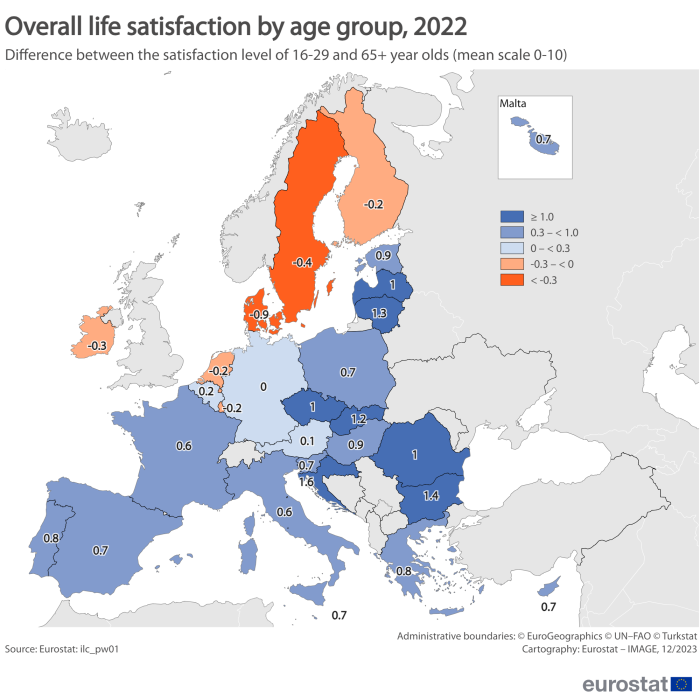Quality of life indicators - overall experience of life
Data extracted in November 2023.
Planned update: December 2024.
Highlights
Overall life satisfaction, 2022
The aim of this article is to capture the trends in subjective well-being of European citizens based on the indicator life satisfaction collected as part of the European Union's (EU's) statistics on income and living conditions (EU-SILC) statistics on income and living conditions (EU-SILC). It is one of the 'Quality of life indicators' articles, providing statistics on the quality of life in the EU. These articles present an analysis of many dimensions of quality of life, complementing the indicator traditionally used as the measure of economic and social development, gross domestic product (GDP).
This article is part of the Eurostat online publication Quality of life indicators, providing statistics on the quality of life in the European Union (EU). The publication presents a detailed analysis of many different dimensions of quality of life, complementing the indicator traditionally used as the measure of economic and social development, gross domestic product (GDP).
The article focuses on overall experience of life, the last dimension of the '8+1' quality of life indicators framework. The first eight quality of life dimensions focus on various individual aspects such as material living conditions and living environment or employment, which are often analysed from both an objective and a subjective perspective. This article focuses on the overall life satisfaction of persons (self-assessed on a 0-10 scale), which is perhaps the only way to integrate the diversity of the experiences, choices, priorities and values of an individual.
Full article
EU citizens were rather satisfied with their lives in 2022
In 2022, Europeans rated their satisfaction with life on average at 7.1 points on a scale from 0 (very dissatisfied) to 10 (very satisfied). The rating was highest in Austria (7.9), Finland, Poland and Romania (each at 7.7) and lowest in Bulgaria (5.6), Germany (6.5) and Greece (6.7). Latvia and Croatia also showed quite low levels of satisfaction at 6.8. However, in all countries except Bulgaria, average levels of life satisfaction were higher than 6, meaning that respondents to the survey declared themselves satisfied rather than dissatisfied (Figure 1).
It is interesting to note that some countries associated with low levels of income in the recent past (as indicated for example by PPP adjusted GDP per capita), such as Romania and Poland, are among the countries where life satisfaction is highest – showing the complexity of the relation between subjective well-being and economic welfare.
Life satisfaction may be influenced by many factors such as age, level of education, family and financial situation. Below some of these factors are analysed.
Young people in the EU were more satisfied with their lives than elderly
In 2022, in most Member States people aged 16-29 showed higher life satisfaction compared to those above 65. The opposite pattern in this respect was seen in Denmark, Sweden, Ireland, the Netherlands, Luxembourg and Finland (see Map 1).
The difference between the subjective wellbeing of young people compared to those above 65 was the biggest in Croatia (+1.6 points), Bulgaria (+1.4 points), Lithuania (+1.3 points) and Slovakia (+1.2 points). In Germany the two age groups had the same average life satisfaction. In Denmark those above 65 had the greatest advantage in life satisfaction compared to youth: 0.9 points. The life satisfaction of young people ranged between 6.3 in Bulgaria to 8.1 in Romania and Poland, while for those above 65 years it was as low as 4.9 in Bulgaria and reached 8.0 in Denmark.
Life satisfaction increased with level of education
In addition to the effect of age, life satisfaction seemed to be dependent upon the level of educational attainment, which to a certain extent also reflected income levels. In every Member State, life satisfaction increased in parallel with the level of education. The highest difference between those with tertiary education and those having primary (less than secondary) education was observed in Slovakia (difference of 1.6 points), Romania and Bulgaria (1.5), as well as Slovenia, Croatia and Hungary (difference of 1.2 points).
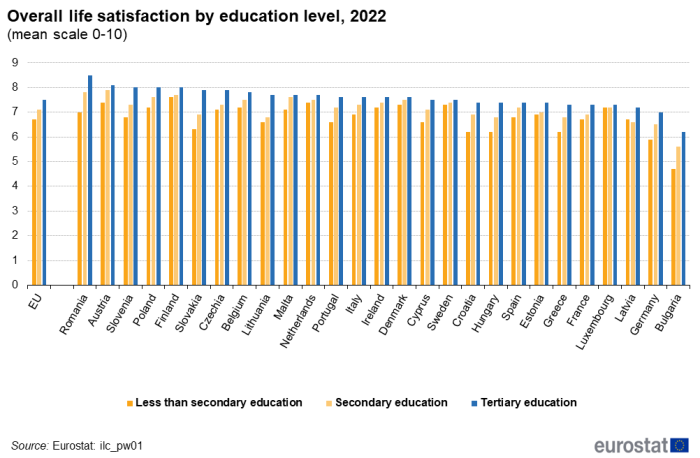
Source: Eurostat (ilc_pw01)
Were people more satisfied in urban or rural areas? Depends on the country
While at EU level, data showed no difference in life satisfaction between urban and rural areas, this concealed opposing trends at Member State level. In Malta, Austria, Finland, the Netherlands, Belgium, Ireland, Sweden, Denmark and Luxembourg people in rural areas declared themselves slightly happier (by at least 0.2 points). On the other hand, in Bulgaria, Romania, Lithuania, Slovakia, Portugal, Hungary, Croatia, Cyprus, Germany and Slovenia people in cities reported higher levels of life satisfaction. The biggest difference was noticed in Bulgaria, where the average life satisfaction of people living in cities was 0.8 points higher than that of those living in rural areas (see Figure 3).
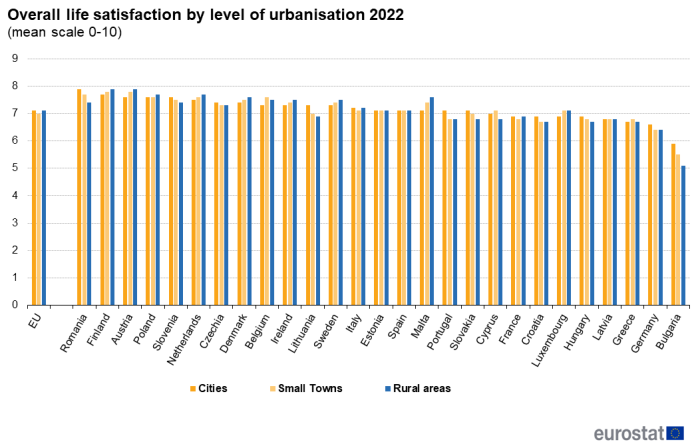
Source: Eurostat (ilc_pw01)
Higher income level and children made Europeans more satisfied with life as a whole
Figure 4 shows that life satisfaction at EU level depended to an extent on household type, almost not at all on sex and quite a lot on level of income.
Regarding the type of household where an individual lives, people in households with dependent children consistently reported the highest levels of life satisfaction. In 2022, at EU level, this was 7.3, compared with an average of 7.1 for couples living together, 7.0 for households with three or more adults and without dependent children, and 6.7 for single person households. The fact that households with dependent children were more satisfied than those without, is rather specific to the European context, as research on other continents has often found the contrary.
Between 2018 and 2022, life satisfaction decreased the most (-0.3 points) for households with dependent children, although they continued to report the highest life satisfaction. During this period, life satisfaction also decreased slightly for all other household types: 0.2 points for households without dependent children and those consisting of two adults, and 0.1 points for single person households and households with three or more adults.
Very little difference was found in the life satisfaction of people by sex. The change between 2018 and 2022 was not uniform, it decreased slightly more for males (-0.3 points) than for females (-0.2 points), both averaging 7.1 at EU level in 2022.
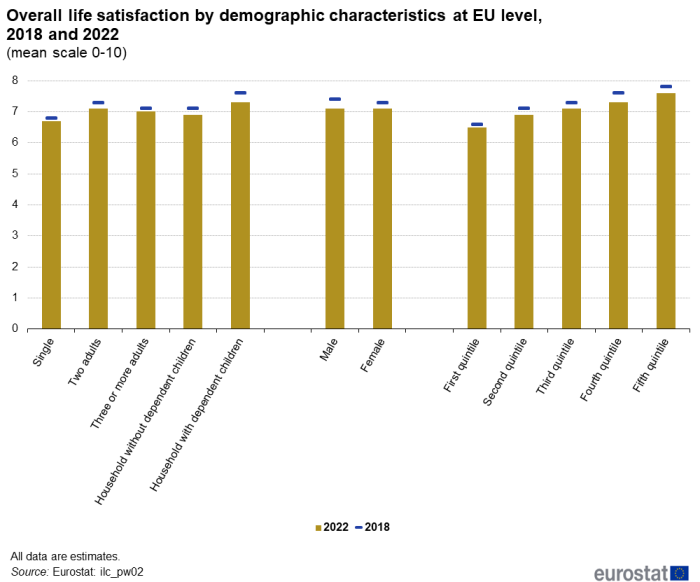
Source: Eurostat (ilc_pw02)
Regarding income level, people with high income tended to be more satisfied with their lives (7.6 on average for the highest income quintile) than those with the lowest earnings (6.5 on average for the lowest income quintile). However, even people in the lowest income quintile tended to be rather satisfied with their lives. While the relationship between income quintile and life satisfaction appeared constant, the second and fourth quintile experienced a larger+ decrease (-0.3 points) than the others between 2018 and 2022. For the first quintile, life satisfaction was stable during this period.
Conclusions
EU citizens tended to be quite satisfied with their life in general, reporting an average of 7.1 points out of 10.0, and in all but one country, the average level was over 6 (i.e., satisfactory and above). There were, however, clear regional patterns: people in the northern, as well as western parts of the EU, tended to be more satisfied with their lives than people in the Baltic countries, the Mediterranean area and eastern parts of the EU. However, a convergence in life satisfaction could be noted between 2018 and 2022: slight increases of life satisfaction took place in countries with generally lower life satisfaction and the opposite in those countries with higher life satisfaction (see dataset ilc_pw01).
Income had an impact on life satisfaction. However, while the highest earners tended to be more satisfied with their lives than those with the lowest incomes, even people in the lowest income quintile tended to be more satisfied with their lives than not. Other demographic and socio-economic factors such as age, educational attainment, household type and degree of urbanisation also played a role in subjective wellbeing ratings. Educational attainment had a positive influence on life satisfaction, as did being part of a couple and having children. There was also a notable age-related pattern. Life satisfaction seemed to decrease with age in the EU, except in some of the countries reporting the highest overall life satisfaction: such as Denmark, Sweden, Ireland, the Netherlands, Luxembourg and Finland, where those aged 65 years and over were more satisfied than the younger generation.
Regarding the overall changes in average subjective well-being between 2018 and 2022, the data showed larger decreases for people with higher levels of education and medium to high income levels as well as for the younger population (aged 16-29 years) when compared with the total surveyed population. The decreases were uniform among men and women.
Source data for tables and graphs
Data sources
Subjective wellbeing encompasses three distinct but complementary subdimensions: life satisfaction (or evaluation), i.e., a person's cognitive overall assessment of their life; affects (the presence of positive feelings, such as joy and the absence of negative feelings, such as sadness or anger); and eudaimonia (the feeling that one's life has a meaning), as specified in the OECD Guidelines on Measuring Subjective Well-being. All three subdimensions were collected in the EU-SILC 2013 ad hoc module on subjective wellbeing and the data collection was partly repeated in the 2018 ad hoc module on Material deprivation, wellbeing and housing difficulties. The variable 'life satisfaction' is collected yearly in EU-SILC starting with 2021, while the frequency of 'being happy' will be collected every 6 years starting with 2022. The variable 'sense of purpose in life' has been discontinued. This article is based only on the yearly variable ‘life satisfaction’.
Context
Measuring well-being has an inherent appeal: promoting the well-being of people in Europe is one of the principal aims of the European Union, as set out by the Treaty on European Union.
Measuring subjective wellbeing also provides valuable insight into the role played by objective capabilities as determinants of well-being. In a comparative European context, we need to take into account the fact that these widely differing priorities and values are also shaped by societal structures, norms and cultural backgrounds, which may vary between countries. The importance assigned to each of the objective dimensions of quality of life may also, therefore, differ at the aggregate country level. Measuring subjective wellbeing also provides valuable insight into the role played by objective capabilities as determinants of well-being.
Life satisfaction involves a cognitive and evaluative reflection on past and present experiences. It provides a more stable perspective. However, this lifetime encompassing perspective also presents difficulties for the statistical measurement of life satisfaction: making an unbiased overall evaluation of one's life requires a survey respondent to make a conscious effort and the results may depend on the timing and circumstances of the survey. For example, the assessment could be influenced by fleeting experiences such as the time of day, day of the week, or even weather conditions, but these influences should cancel out in a large sample. An additional methodological difficulty stems from the entirely subjective nature of this metric. In other aspects of quality of life, which focus on functional capabilities, assessments based on perceptions can often be compared with and cross-checked against objective measures. There is, however, no such objectively measurable counterpart for life satisfaction. Nonetheless, this is a measure easy to comprehend and communicate.
Direct access to
Database
- Quality of life, see:
- Material living conditions (qol_mlc)
- Productive or other main activity (qol_act)
- Health (qol_hlt)
- Education (qol_edu)
- Leisure and social interactions (qol_lei)
- Economic security and physical safety (qol_saf)
- Governance and basic rights (qol_gov)
- Natural and living environment (qol_env)
- Overall experience of life (qol_lif)
